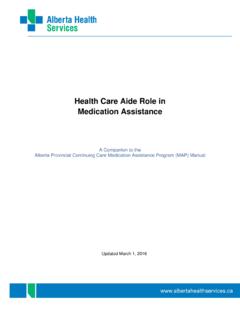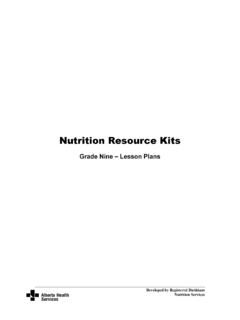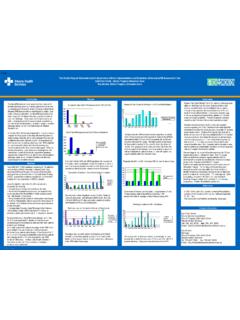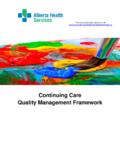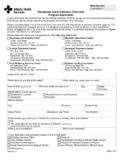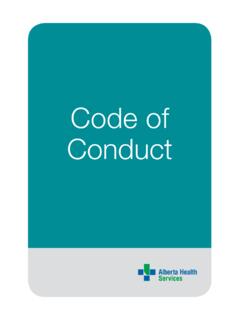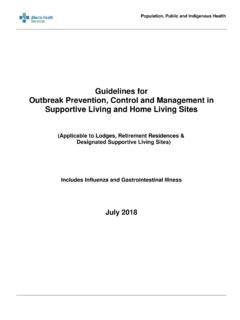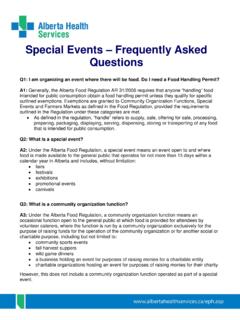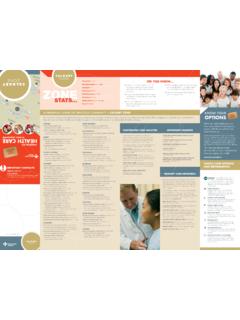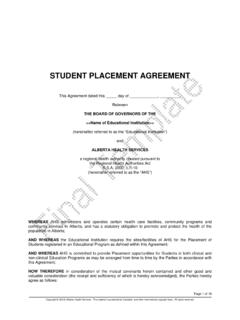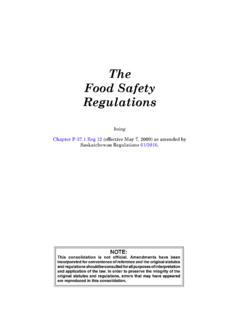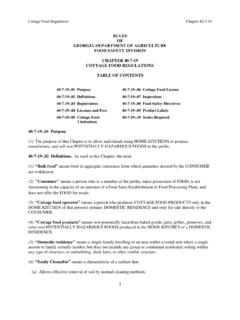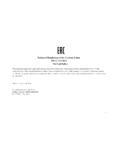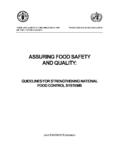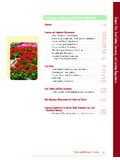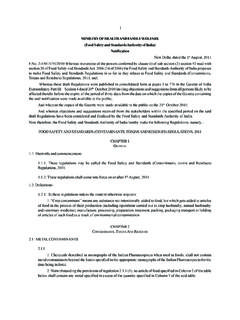Transcription of Alberta Food Safety Basics Booklet - Alberta Health Services
1 Alberta food Safety Basics Booklet 2 Alberta Health Services Environmental Public Health Alberta food Safety Basics Booklet Table of Contents Introduction and How to Access 3 Section 1: food Safety In 4 Section 2: Foodborne 5 Section 3: The Causes of Foodborne 8 Section 4: How to Prevent Foodborne 16 Appendix A: Foodborne Illness Chart .. 34 Acknowledgement: Much of this course material was taken from the former Calgary Health Region s food Safety in food Service: A Home Study Course. Copyright 2002, Revised 2009 The funding for that project was provided by the Alberta Lottery Fund.
2 3 Who should read this Booklet : This Booklet can be read by anyone who prepares food including people working in food businesses, daycares, long term care facilities, volunteers, and those who cook at home. Read through each section of this Booklet and do the review questions. Test: The test is optional and has a total of 25 questions. The passing mark is 80%. Once you pass the test, you will be able to view and print an Alberta food Safety Basics certificate which is valid for three years. You will need access to a printer to print the certificate.
3 Note: this certificate replaces the Home Study in food Safety certificate. How to access the test: 1. Go to AHS-EPH Education Courses page: 2. Click Alberta food Safety Basics link 3. Self-Enroll in this course 4. Access this Booklet on Alberta food Safety Basics course page under: Booklet and Test Option (if Alberta food Safety Basics online course doesn t work) 5. After reviewing the Booklet , click on Mark Reviewed 6. The test will appear. Click on link to access test 7. Once you have completed and received 80% on the test, view and print your certificate Reading the Booklet and completing the test is equivalent to taking the online, interactive Alberta food Safety Basics course which is available on the Alberta food Safety Basics course page.
4 Please note that this course does not meet provincial certification requirements. Alberta food Safety Basics Booklet and Test The test must be accessed and completed online. Tests sent in by email, fax or mail will NOT be accepted. 4 Section 1. food Safety in Alberta food INSPECTIONS The Alberta Health Services (AHS) food inspection program is carried out by certified Public Health Inspectors (PHIs) / Environmental Health Officers (EHOs) who work for Environmental Public Health . All public food facilities, from hot dog carts, grocery stores, to full service restaurants are inspected.
5 A Health Inspectors authority lies within the Alberta Public Health Act. During food inspections, Health Inspectors ensure that operators are following government legislation such as the Alberta food Regulation. The food Regulation requires that a food establishment must hold a valid food handling permit issued by AHS. To make an application for a food handling permit, visit the website or contact your local Health Inspector. There are a few exceptions to the requirement for a food handling permit. Special events, temporary food establishment and community organization functions do not require a food handling permit, although they do require approval from AHS and must follow regulatory requirements to ensure food is handled in a safe manner.
6 The Public Health Act and the food Regulation are available online at the Alberta Queen s Printer website at or by telephone at (780) 427-4952. Restaurant inspections can be viewed at . Court cases and food establishment closures can also be viewed at this site. food Safety EDUCATION The Alberta food Regulation states that food operators are responsible for completing the appropriate food Safety training. There is a requirement for one person per shift to have provincially recognized food Safety certification if there are six or more food handlers on site.
7 food handlers include cooks, servers and bartenders. If there are less than six food handlers on site, one person in care and control of the establishment must have certification. This person should be on site most of the time. Information on provincial certification in food sanitation and hygiene can be found at Alberta food Safety Basics Booklet and test is equivalent to a short 2 3 hour course and does not provide provincial certification. 5 Section 2. Foodborne Illness Each year an estimated million Canadians are ill from foodborne illness.
8 Many people do not report foodborne illness to the Health department or their doctor. Foodborne illness, commonly called food poisoning, is caused by consuming food or beverages contaminated with bacteria, the toxins or poison that some bacteria produce, viruses, parasites, or moulds. These are called pathogens or harmful microbes. Anyone can become ill with foodborne illness. However, some people are at a higher risk for food -borne illness. These include: babies or very young children seniors pregnant women sick people people with little resistance to illness; for example cancer, transplant and AIDS patients Common symptoms of foodborne illness: diarrhea vomiting nausea stomach cramps headache fever Symptoms can last for several hours, days or months.
9 Foodborne illness can cause mild illness or very serious illness. People may have to stay off work. Sometimes people have to go to the hospital. Foodborne illness can even cause death. A Listeria outbreak in 2008 caused 23 deaths in Cana-da. The outbreak was linked to ready-to-eat deli meat products contaminated at a Canadian food plant. Listeriosis is a rare but seri-ous foodborne illness and can result in death. Preg-nant women, the elderly and people with weakened im-mune systems are at the greatest risk of becoming ill. Information on Listeria and other foodborne illnesses can be found at: Canadian food Inspection Agency, Causes of food -borne Illness, 6 FACTS food that contains harmful microbes (germs) or their toxins (poison) may look, taste, and smell normal.
10 In many cases, foodborne illness is not caused by the last meal or food eaten. It can take time for symptoms to develop. With E. coli O157:H7 infection (a type of foodborne illness), it can take 2-10 days for the signs of illness to appear. It can take 6-72 hours for the symptoms of Salmonella infection to appear. It takes only a small number of microbes to cause some types of foodborne illness. Two examples are Shigella infection and O157:H7 infection. The harmful microbes that cause foodborne illness can also be spread by contact with another person, touching an animal, and swimming or wading in recreational pools.
